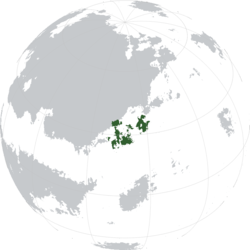Milevian Confederacy
| Milevian Empire | |||||
| TBA | |||||
| |||||
| Capital | Phamphar (de facto) | ||||
| Languages | Imperial Milevian Old High Czisilian Others | ||||
| Government | Elective monarchy | ||||
| Grand Steward | |||||
| • | X | Jaddemarrash (first) | |||
| Legislature | Stewards' Council | ||||
| Historical era | Late Middle Ages | ||||
| • | Established | 1200s | |||
| • | Collapse | 1600s | |||
| Today part of | Others | ||||
The Milevian Empire was a somewhat loose confederation of Milevic chiefdoms in eastern Parshita. It existed from X until its collapse in the 17th Century.
The empire was founded upon and organised around a unique system of clans and sodalities wherein ruling clans of chiefdoms would band together regardless of kin to form a guild that performed a certain function (for example, a fishing sodality). This was a voluntary association as opposed to a system of vassalage, and as such the individual chiefdoms enjoyed a great degree of autonomy prior to the later years of the empire. Within the empire this system allowed regions to become specialised in the provision of a particular good or service.
Terminian influence and attempts to centralise the empire led to its downfall in the 17th Century. In the years following its collapse the former empire was conquered and incorporated into the Terminian Far East.
Etymology
History
Establishment
Arrival of Terminians
Terminian traders first made contact with the Milevian Empire in [year], establishing a trading relationship shortly thereafter. Terminian merchants began to acquire trading rights within the empire, particular in key port cities such as Aśkal. The presence of Terminian traders brought Pashaism to Milevia for the first time, with the religion becoming predominant in the western and southern territories of the empire, spreading from Terminian port cities, in part due to the conversion of the ruling clans to the religion, in part for political reasons. While initially peaceful, the spread of Pashaism sowed the seeds for a cultural conflict, as traditional beliefs and the newly introduced Pashaism were ever increasingly seen as incompatible with one another, with beliefs concerning the environment, the natural order, and the preservation thereof being a particular sticking point.
In response to increased Terminian influence and questions of the loyalty of the Pashaist clans to the confederacy, the empire began to transition to a system of government featuring an increase in centralisation, initiated by the Union Reforms in [year]. This transition, while initially met with moderate disdain, faced considerable opposition from certain clans, including the [TBD] clan who governed territories in the south of modern-day Farmosh, who saw their previous freedom to conduct business as usual being threatened. Tensions came to a head upon the issuing of the [TBD] decree, which officially favoured Hurodism over Pashaism within the empire.
Collapse
Geography
Politics
Administrative Divisions
The empire was divided into a multitude of individual chiefdoms, each headed by a different ruling clan.
Government
Each chiefdom within the confederation was placed in a regional grouping overseen by a steward elected by the clans in a region, usually from their own ranks, who would oversee business and trade and resolve disputes between the clans under their jurisdiction. In the later stages of the empire these regions became de facto provinces, while the chiefdoms played a role more akin to districts within them.
In addition to regional stewards, every ruling clan would occasionally elect a grand steward, a de facto emperor.
